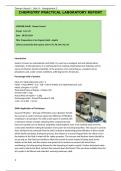Osman Yousuf – Unit 4 – Assignment 2
CHEMISTRY PRACTICAL LABORATORY REPORT
LEARNER NAME: Osman Yousuf
Group: A.A, E.H
Date: 28/03/2024
Title: Preparation of an Organic Solid - Aspirin
Criteria covered by this report: Unit 4, P5, P6, M4, M5, D3
Introduction
Aspirin is known as acetylsalicylic acid (ASA), it is used as an analgesic and anti-inflammatory
medication. In the laboratory, it is synthesised from reacting 2-hydroxybenzoic (Salicylic) acid in
excess of ethanoic (Acetic) anhydride, in the presence of an acid acting as a catalyst such as
phosphoric acid, under certain conditions at 80 degrees for 30 minutes.
Percentage yield of product
Mass of 2-Hydroxybenzoic acid = 2
Moles = Mass/RMM = 2. = 0.0145 (Moles of 2-Hydroxybenzoic acid
Moles of Aspirin = 0.0145
Theoretical Mass of Aspirin = Moles X Mr
0.0145 X 180 = 2.6g
Actual Mass of Aspirin = 1.38g
Percentage yield = Actual/Theoretical X 100
1..6 X 100 = 53.1%
Skilful Application of Techniques
Vacuum Filtration – this type of filtration uses a Buchner Funnel,
the vacuum is used to increase speed and efficiency of filtration,
resulting in a dry product, the solid crude aspirin is washed with
a minimum volume of water, allowing other components that
have not reacted such as ethanoic anhydride and phosphoric acid, to be washed away from the
crude solid, therefore making the product more purer by removing impurities. The vacuum is used to
force all liquid to be removed from the solid, instead of performing gravity filtration as there would
still be liquid remaining. During the process, the mixture is in a pear-shaped flask, the silicon oil on
the bottom of the flask is wiped off for safety purposes. The vacuum and Buchner funnel should be
set up and on, the flask was swirled to allow the crystals to move instead of being stuck at the
bottom of the flask, and the mixture was poured in in sections to prevent the funnel from
overflowing, this slow pouring allowed for the loosening of aspirin crystals. Further deionised water
was used to add to the flask, swirled, then poured down the funnel. This was done multiple times for
all crystals to be filtered and collected, ensuring maximum yield.
1
, Osman Yousuf – Unit 4 – Assignment 2
Hot and Cold Filtration, – this filtration is known as gravity filtration
using fluted filter paper. Two conical flasks were set up, one with a
fluted filter on top, they were both placed on a heating mantle, the
crude aspirin, was placed in the conical flask with hot solvent (ethanol)
by using a spatula, and swirling the flask regularly, helping the aspirin
dissolve in the conical flask. This is known as hot filtration, it dissolves
desired sample of aspirin, but does not dissolve insoluble impurities.
The filter paper of the Büchner funnel was also placed in the ethanol
solution to ensure all aspirin is transferred to limit transfer errors, and
lack of yield.
The ethanol and aspirin were poured into the other conical flask with
a fluted paper, this is hot gravity filtration, then safely removed and
transferred into a labelled beaker. The aspirin now has been purified,
and removed from any insoluble solids, which is added with deionised
water and left to recrystallise. After crystallised it undergoes vacuum
filtration again (cold filtration) where the aspirin is decanted, the soluble impurities will remain in
solution, the aspirin crystals are left to dry in the oven at 60 degrees. The product is now purified
Aspirin.
Chromatography – this a technique used for separating mixtures into their compounds.
Chromatography can also be used to determine if a substance synthesis (aspirin) is pure and matches
the reference sample in terms of distance travelled. This distance made by compounds are
dependent on polarity. Polar compounds are strongly adsorbed to the stationary phase, they strongly
interact with hydroxyl groups of silica, thus will move slowly and not make much distance from
starting line. Non-polar compounds weakly interact with the hydroxyl groups, thus more solubility in
mobile phase. All aspirin samples were tested on one plate, which included the reference sample of
aspirin for comparison.
The normal samples were placed on the right and the reference sample on the left. The solvent front
was 43mm, with all samples measured at 12mm, the Rf value was calculated as 0.28 for all samples.
As the samples had the same Rf value as the reference it highlights the high purity of the samples
synthesised. Additionally, only one spot was produced, impurities within the sample would’ve caused
separations from different interactions.
Melting Point – this is the temperature point from where a solid changes into a liquid. To determine
this, a melting point apparatus was used. The sample was carefully placed into a melting capillary
tube and the tube was placed in one of the designated spots.
2




